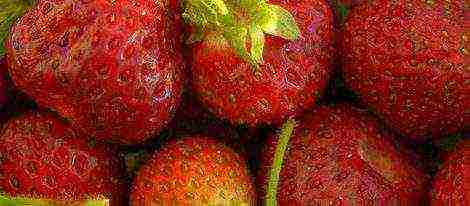Content
- 1 Description
- 2 Growing ampelous petunia seedlings from seeds
- 3 Landing in open ground
- 4 Petunia ampelous: features of care
- 5 How to care for the soil
- 6 Pruning and shaping the bush
- 7 Do I need to pinch ampelous petunia
- 8 Disease and pest control
- 9 How a flower reproduces
- 10 Growing in pots
- 11 Petunia ampelous and cascading - what's the difference?
- 12 The best varieties of ampelous petunias
- 13 Planting and caring for ampel petunia at home
- 14 How to form an ampelous petunia?
- 15 How to collect seeds?
- 16 Conclusion
- 17 Name
- 18 Origin
- 19 Description
- 20 Types and varieties
- 21 Choosing a place for a plant
- 22 Care
- 23 Pests, diseases
- 24 Reproduction
- 25 Partners
Refined beauty and unpretentious care are harmoniously combined in such an elegant flower as ampelous petunia. A spectacular representative of the flora with thin shoots and a waterfall of falling flowers, which is not inferior in decorativeness to a rose, will become a marvelous decoration of any garden and courtyard.
Description
An ornamental plant with characteristic long shoots, covered with large flowers of a wide color range, allows flower growers to decorate hanging pots, flowerpots at the entrance, as well as flower beds and flower beds with the help of an original culture. Thanks to the constant work of domestic and foreign breeding institutes, today flower shops present a wide range of various varieties of beautiful flowers.
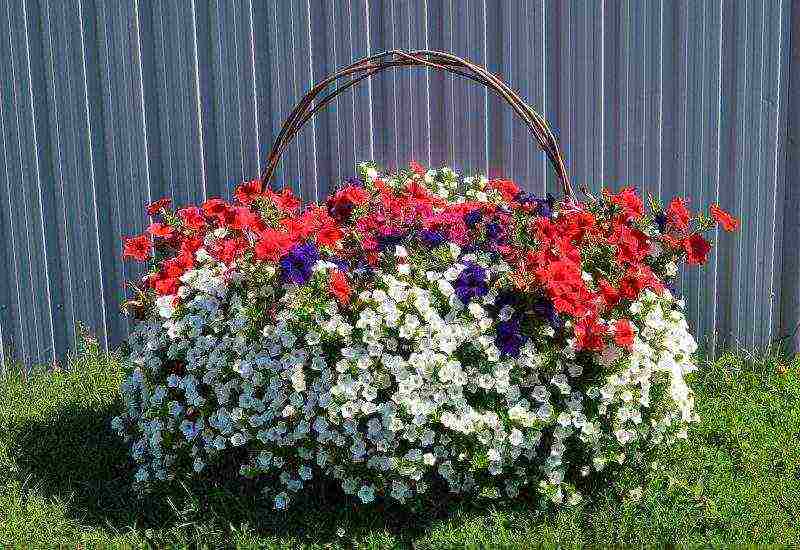
Most Popular:
- "Snow Queen" is a variety with snow-white flowers that exude a wonderful aroma and refresh the landscape.
- "Explorer" - a representative with powerful shoots, covered with flowers of various colors, easily tolerates bad weather.
- "Mashenka" is a plant with 80 cm shoots, which are covered with alternate, short-petiolate leaf plates and medium-sized pink or yellow flowers.
- "Ekaterina" is an orange hybrid with small flowers, the diameter of which does not exceed 6 cm.
- "Svetlana" is an elegant variety with flowers that stand out with pink veins and branchy shoots up to 1 m long.
- "Black Velvet" - a distinctive feature of the variety is the almost black color of flowers up to 8 cm in diameter.
- "Ramblin Neon Roses" is a decorative large-flowered form of ampelous petunia that grows up to 1 meter wide.
Growing ampelous petunia seedlings from seeds
Since the pace of development of ampelous petunia is rather slow, it is worth growing the culture using the seedling method, which will allow you to get a flowering plant by summer.
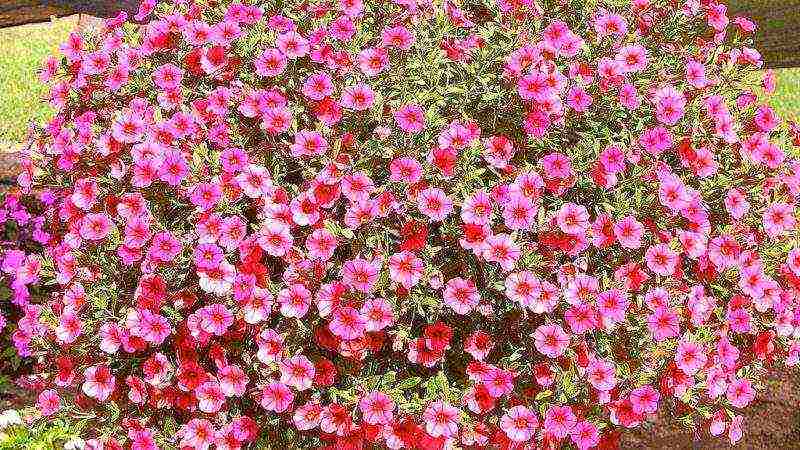
Sowing seeds is carried out in late winter - early spring as follows:
- The container for seedlings is disinfected and filled with a light, fertile substrate with a loose structure.
- The soil is pre-calcined in the oven to destroy pathogens and pest larvae, and then watered with a strong solution of manganese directly in the box.
- After the soil is slightly "shaken", the seed is spread over its surface.
- The container is covered with glass and installed in a warm, shaded place.
- After the emergence of seedlings and the development of 3 pairs of true leaves, the protective glass is removed, and the seedlings are dived into separate containers, which are moved to diffused light, where they are kept until the return frosts in the garden have passed.
- During the growth of seedlings, in order to ensure lush flowering of petunias, the seedlings are fed with mineral fertilizers twice a month and systematically moistened to prevent the earthen coma from drying out.
Landing in open ground
At the end of spring, when the soil warms up enough and stable heat comes, you should start planting seedlings driven out at home in open ground.

It is worth planting petunia in the evening or on cloudy days in pre-prepared holes.
Planting holes with dimensions of 10x10 cm are dug in sunny or slightly shaded areas with a distance of 25 cm. The soil on the site should be fertile and loose with good drainage qualities. After planting the specimens of the beds, it is recommended to mulch, which will maintain the required level of moisture in the near-trunk circles.
Petunia ampelous: features of care
It is very simple to care for a rather undemanding flower and this process will not cause trouble even for a beginner or a grower who does not have a lot of free time.
Watering and feeding
The key to the successful cultivation of ampelous petunia is to ensure a high level of soil and air humidity, at which the soil will always be in a slightly moist state. In hot summer conditions, it is recommended to periodically sprinkle the beds, thereby reducing the dryness of the air.

To ensure abundant flowering and the overall attractiveness of the bushes, additional nutrition should be organized for the beautiful inhabitant of the garden. During the period of growing green mass, fertilizing is carried out with an increased concentration of nitrogen, which, as the buds begin to form, is replaced by phosphorus-containing fertilizers. At the end of flowering, it is worth enriching the soil under the plantings with potassium, which strengthens the flower's immunity. In addition to root dressings, ampelous petunia responds well to foliar applications using liquid mineral complexes, as well as growth stimulants.
How to care for the soil
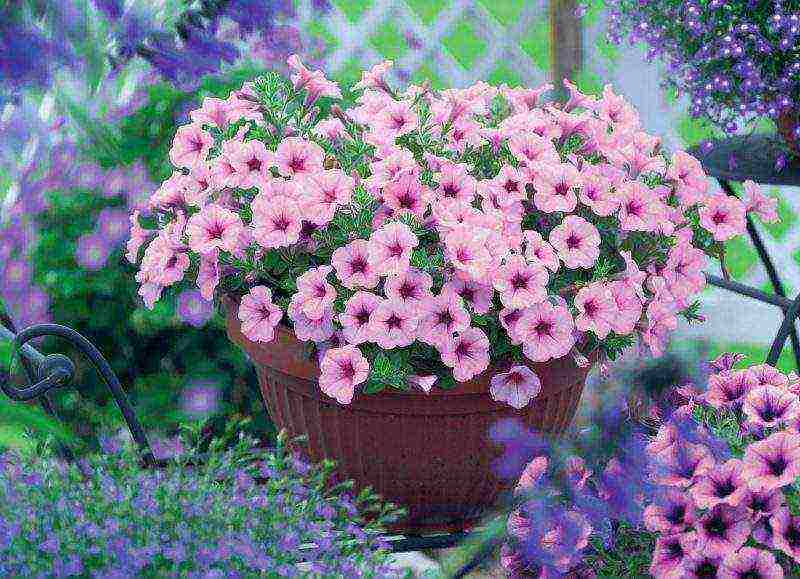
It is recommended to loosen the beds several times during the growing season, providing loose soil and free air circulation. Covering the trunks with a layer of peat mulch will prevent rapid evaporation of moisture and save time on loosening.
Pruning and shaping the bush
The formation of ampelous petunia involves the timely shortening of the overgrown stems by ⅔ of the length, which will preserve the attractiveness of the bushes and prevent exposing their lower part.

Due to the fragility of long shoots of petunia under the influence of wind and precipitation, to maintain the decorative effect of the flower and stimulate abundant flowering, it is recommended to systematically carry out sanitary pruning, removing the injured parts of the green mass. Also, as necessary, seed pods are cut from spectacular bushes, spoiling the overall appearance of the plant.
Do I need to pinch ampelous petunia

To increase the decorative qualities of the plant by growing in width and the formation of strongly branching shoots, it is necessary to pinch the flower. To achieve the set task and increase the number of flowers in young plants, all growth points on the newly emerging shoots are removed.
Disease and pest control
Ampel petunia, subject to the care regulations, is rarely affected by pests and diseases. However, with too thick plantings and in conditions of systematic waterlogging on the plant, manifestations of powdery mildew and gray rot can be observed, the spread of which occurs very quickly. At the first symptoms of disease, the affected parts of the shoots are removed and burned, and the remaining plantings are treated with systemic fungicides that prevent the further development of pathogenic fungi.

Among the pests, aphids, thrips and spider mites that populate the flower at low air humidity stand out.To prevent attacks, sprinkling of the petunia should be organized. But if harmful insects are already marked on the plant, you should immediately treat the beds with an insecticide according to the manufacturer's instructions on the package.
How a flower reproduces
In addition to the seed method of reproduction, which is characterized by laboriousness and duration, ampelous petunias, being perennials, can reproduce by a vegetative method.
With green cuttings:
- Cuttings 5 - 6 cm long are cut from the ripened shoots, from the bottom of which all foliage is removed.
- Individual pots are filled with peat and sand substrate.
- The cuttings are buried in the prepared soil and watered with a growth stimulant.
- Rooting, in which the cuttings are under protective caps, occurs after 4 to 8 weeks.
- During the entire period, the plantings are moistened and ventilated.
Growing in pots
Hanging pots are very often decorated with ampelous petunias with bright flowers, which allow you to maintain the decorative appearance of the bowls for a long time. However, due to the tendency of petunia bushes to grow and thicken, which can cause the development of diseases and a loss of attractiveness, the florist must know exactly how many bushes to plant in one bowl. The key parameter when calculating the number of pieces is the diameter of the planter.
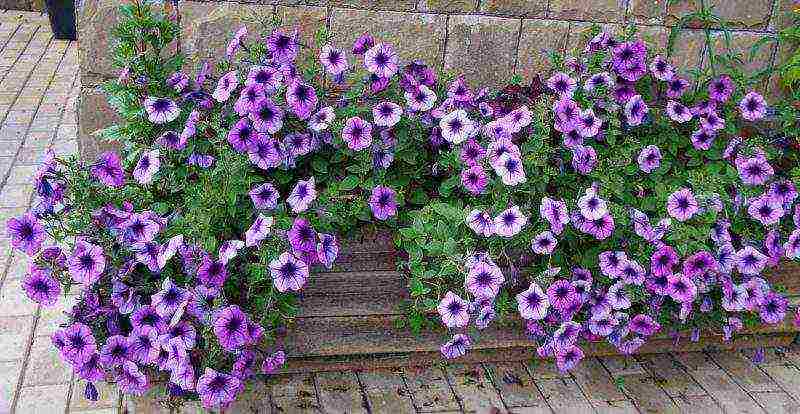
In order for a bowl with a diameter of 30 cm to be a spectacular decoration of the garden, it is enough to plant 2 - 3 copies of the ampelous beauty in it.
Petunia ampelous is a beautiful flower with a long and lush flowering, which, subject to simple care procedures, will decorate the garden with bright colors for a long time.
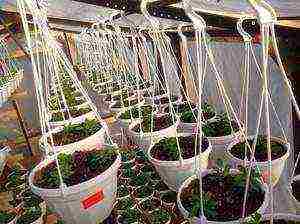 Summer is the most beautiful time of the year, when nature, showing a variety of colors, is an unforgettable pleasure. Contemplating this picture, many have a desire to make the territory adjacent to the house, a balcony or a summer cottage no less beautiful. Often this problem is solved quite simply - they plant the flowers they like so that both close people and ordinary passers-by can admire them. And a good idea to decorate the chosen place is to plant an ampelous petunia.
Summer is the most beautiful time of the year, when nature, showing a variety of colors, is an unforgettable pleasure. Contemplating this picture, many have a desire to make the territory adjacent to the house, a balcony or a summer cottage no less beautiful. Often this problem is solved quite simply - they plant the flowers they like so that both close people and ordinary passers-by can admire them. And a good idea to decorate the chosen place is to plant an ampelous petunia.
This plant is distinguished by long shoots covered with large bright flowers. Therefore, it can be grown both on the balcony and in a box or around a garden path. Thanks to this plant, it will be quite easy for you to maintain a colorful and summer atmosphere in your space.
Petunia ampelous and cascading - what's the difference?
Petunia is known to experts for its whimsical nature. And this is not surprising, given that its natural habitat is humid and hot climate... But thanks to the efforts of breeders today, hybrids are available to every novice florist and not only, which are easy to grow and care for and at the same time can delight in appearance throughout the summer season.
Although it is customary to distinguish ampelous and cascading petunias, in reality they have no differences. After all, this is one and the same plant, which simply has different names.
The best varieties of ampelous petunias
The range of flower shops today offers many different varieties of ampel petunias. This simplifies the task for the gardener, since he can choose the variety that suits him. The most demanded today are the following varieties of petunias:
-
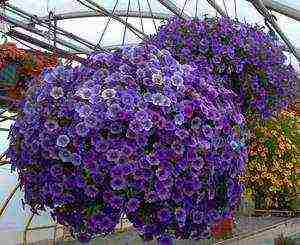 Sort "Snow Queen". Its main advantage is its unique aroma. Snow-white flowers make it attractive, giving the effect of purity and lightness;
Sort "Snow Queen". Its main advantage is its unique aroma. Snow-white flowers make it attractive, giving the effect of purity and lightness; - Variety "Explorer". Differs in a rich color palette. It grows in height up to 1.5 meters. Differs in large and strong stems, due to which it tolerates bad weather well;
- Variety "Ekaterina". The plant has orange flowers decorated with veins. Flowers are small, 6 cm in diameter;
- Variety "Black Velvet".It stands out on the list of varieties because of its large black flowers. The flowers are small, have a diameter of 8 cm;
- Variety "Milliflora". It stands out among other varieties for its compact size. This plant will appeal to gardeners who love cute and touching style.
Choosing terry varieties of petunias for growing on the site, you need to be prepared for the fact that they requires careful care... In order for the flowers of this plant to be endowed with their beauty, you will have to make a lot of effort. Due to the difficulties that arise when growing them, they are most often planted in closed places.
Planting and caring for ampel petunia at home
It is difficult to find such a grower who would be indifferent to petunias. Today, it is customary to distinguish two types of this plant: bush and ampelous. Moreover, each of them has expressiveness and attractiveness. Shrub petunias have become widespread as garden plants, and ampelous ones are mainly grown at home, where they decorate balconies and verandas. However, regardless of the variety of petunias chosen, it is imperative to provide appropriate care.
Growing seedlings from seeds
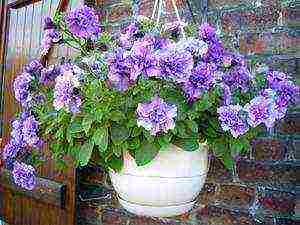 Due to the scarce baggage of knowledge, novice florists pay attention to every little thing... They may be interested in known methods of combating diseases, as well as the question of how many pieces to plant in pots. However, the first thing they need to do is get an answer to the question of how to grow plants from seeds.
Due to the scarce baggage of knowledge, novice florists pay attention to every little thing... They may be interested in known methods of combating diseases, as well as the question of how many pieces to plant in pots. However, the first thing they need to do is get an answer to the question of how to grow plants from seeds.
If it is possible to provide artificial lighting for seedlings, sowing petunia seeds can already be in February. Otherwise, you need to wait with this until mid-March, since at this time the daylight hours will become longer, which will provide the petunia with the necessary amount of light. The soil used for sowing should have a loose, nutritious and light texture. To prepare planting soil that meets the above requirements, you will need the following components:
- two parts of peat;
- two parts of sod and leafy soil;
- two parts of humus;
- one piece of sand.
The top layer of soil should be as light as possible, so it is advisable to sift it. The day before sowing, the soil must be watered. Then you need to add a little dry sand to the seeds, after which this mixture is placed on the prepared soil. It is possible to accelerate seed germination if the container with crops is covered with foil or glass and transferred to a room where the temperature will be maintained at 21-22 degrees.
The appearance of the first shoots should be expected after a week. From this point on, the seedlings need to be carefully cared for. To do this, the seedlings are watered twice a day, sprinkling with room water. Also it is necessary to air... It is difficult to grow strong and healthy seedlings without maintaining optimal air humidity. At the same time, you need to ensure that condensation does not occur, since if it is present, the likelihood of damage to seedlings by various diseases increases. After waiting for the formation of the first leaves of the seedlings, the film can be removed.
Watering and fertilizing
 Petunia makes rather high demands on growing, so beginner growers may have certain difficulties. The plant will be able to fully demonstrate its decorative properties only under the condition of carrying out nutritious dressings. No less important is watering for petunias, which must be carried out every day.
Petunia makes rather high demands on growing, so beginner growers may have certain difficulties. The plant will be able to fully demonstrate its decorative properties only under the condition of carrying out nutritious dressings. No less important is watering for petunias, which must be carried out every day.
If the seedlings receive less required amount of moisture, then this will lead to the development of diseases, which can be determined by various characteristic signs. For example, its leaves become sticky. In order for the plant to be provided with all the necessary nutrients, it is recommended to carry out top dressing with special compounds that must be added to the soil with each watering. The greatest effect of dressings is achieved if the scheme is followed:
- the first seven days - watering with water and humates;
- the next seven days - watering with water and potassium sulfate.
Planting flowers in open ground
When the seedlings grown in pots are strong enough, you can choose a place for planting in open ground. However, for this event to take place without complications, it is necessary take into account the following recommendations:
- it is advisable to transplant in the evening in cloudy weather;
- it is recommended to transfer seedlings to a prepared place together with the soil from the pots;
- prepared seedling holes must be at least 10 x 10 cm;
- it is also important to correctly determine the distance between seedlings, focusing on their size. If a variety with large flowers is transplanted, then the plants are placed at least 24 cm from each other. For plants with small flowers, it is sufficient to maintain an interval of 19 cm. For ampel petunia bushes, a distance of about 29 cm must be maintained;
- when the transplant is completed, it is necessary to carry out activities to accelerate rooting. For this, the soil is mulched with peat or humus. In this way, plants will be protected from low temperatures, which will also help maintain optimal moisture levels;
- upon completion of all transplant operations, the flower must be watered.
How to form an ampelous petunia?
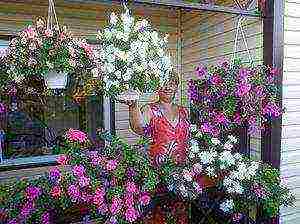 As a rule, by mid-July, the shoots grow too much, requiring prompt removal. Moreover, this also happens if the petunias are provided with minimal care. In such conditions, there is exposing the lower part of the shoots, at the same time, new buds and leaves are formed at the tops. As a result, the flower becomes unattractive, there is a delay in growth, since it does not receive the necessary nutrients.
As a rule, by mid-July, the shoots grow too much, requiring prompt removal. Moreover, this also happens if the petunias are provided with minimal care. In such conditions, there is exposing the lower part of the shoots, at the same time, new buds and leaves are formed at the tops. As a result, the flower becomes unattractive, there is a delay in growth, since it does not receive the necessary nutrients.
It is possible to maintain a healthy and attractive petunia provided that the shoots are pinched in time. The essence of this procedure is to remove the shoot by 2/3 of the length. This operation is the meaning of the formation of an ampelous petunia. If carried out in a timely manner, it is possible to ensure an attractive appearance of the flower throughout the growing season.
How to collect seeds?
Experienced growers know that it is enough to extend the flowering period of petunias promptly cut withered flowers... However, they are the seed suppliers. At the first signs of flowering, you need to start observing the lower flowers and choose the most suitable ones. You can use buds that have withered and have time to fully ripen. This ensures that they contain quality seeds. It usually takes 2.5 months for the seeds to ripen.
You can get the required amount of seeds and the proper quality only if a suitable variety was initially selected. In this regard, terry petunia, which does not transmit maternal properties to the offspring, is not an entirely suitable choice. Therefore, even experienced flower growers cannot guarantee that when creating the necessary conditions for plants after sowing the collected seeds from them a new flower will grow of the same grade. In some cases, a surprise is possible - from the sown seeds, flowers that have different sizes, shapes and shades can often grow.
Conclusion
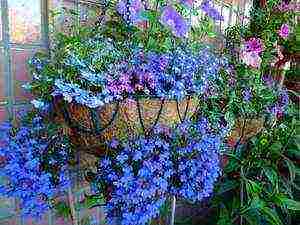 Petunia is a rather unique plant, because with all its excellent decorative properties, it is rather difficult to grow this plant in the absence of the necessary knowledge. Therefore, for novice gardeners, this can be a serious problem, especially if they plan to plant it in open ground.
Petunia is a rather unique plant, because with all its excellent decorative properties, it is rather difficult to grow this plant in the absence of the necessary knowledge. Therefore, for novice gardeners, this can be a serious problem, especially if they plan to plant it in open ground.
However, if you use the accumulated experience of gardeners, you can successfully grow this capricious plant in our latitudes. You can increase the chances of success if the petunia is grown by seedling. Then the grower will have at his disposal strong and hardened seedlings, which, with appropriate care during the planting period, will feel quite comfortable in the prepared flower bed.
Rate the article:
(11 votes, average: 3.9 out of 5)
 Summer is the most beautiful time of the year, when nature, showing a variety of colors, is an unforgettable pleasure. Contemplating this picture, many have a desire to make the territory adjacent to the house, a balcony or a summer cottage no less beautiful. Often this problem is solved quite simply - they plant the flowers they like so that both close people and ordinary passers-by can admire them. And a good idea to decorate the chosen place is to plant an ampelous petunia.
Summer is the most beautiful time of the year, when nature, showing a variety of colors, is an unforgettable pleasure. Contemplating this picture, many have a desire to make the territory adjacent to the house, a balcony or a summer cottage no less beautiful. Often this problem is solved quite simply - they plant the flowers they like so that both close people and ordinary passers-by can admire them. And a good idea to decorate the chosen place is to plant an ampelous petunia.
This plant is distinguished by long shoots covered with large bright flowers. Therefore, it can be grown both on the balcony and in a box or around a garden path. Thanks to this plant, it will be quite easy for you to maintain a colorful and summer atmosphere in your space.
Petunia is known to experts for its whimsical nature. And this is not surprising, given that its natural habitat is humid and hot climate... But thanks to the efforts of breeders, today hybrids are available to every novice florist and not only, which are easy to grow and care for and at the same time can delight in appearance throughout the summer season.
Although it is customary to distinguish ampelous and cascading petunias, in reality they have no differences. After all, this is one and the same plant, which simply has different names.
The range of flower shops today offers many different varieties of ampel petunias. This simplifies the task for the gardener, since he can choose the variety that suits him. The most demanded today are the following varieties of petunias:
 Sort "Snow Queen". Its main advantage is its unique aroma. Snow-white flowers make it attractive, giving the effect of purity and lightness;
Sort "Snow Queen". Its main advantage is its unique aroma. Snow-white flowers make it attractive, giving the effect of purity and lightness;- Variety "Explorer". Differs in a rich color palette. It grows in height up to 1.5 meters. Differs in large and strong stems, due to which it tolerates bad weather well;
- Variety "Ekaterina". The plant has orange flowers decorated with veins. Flowers are small, 6 cm in diameter;
- Variety "Black Velvet". It stands out on the list of varieties because of its large black flowers. The flowers are small, have a diameter of 8 cm;
- Variety "Milliflora". It stands out among other varieties for its compact size. This plant will appeal to gardeners who love cute and touching style.
Choosing terry varieties of petunias for growing on the site, you need to be prepared for the fact that they requires careful care... In order for the flowers of this plant to be endowed with their beauty, you will have to make a lot of efforts. Due to the difficulties that arise during their cultivation, they are most often planted in closed places.
It is difficult to find such a grower who would be indifferent to petunias. Today, it is customary to distinguish two types of this plant: bush and ampelous. Moreover, each of them has expressiveness and attractiveness. Shrub petunias have become widespread as garden plants, and ampelous ones are mainly grown at home, where they decorate balconies and verandas. However, regardless of the variety of petunias chosen, it is imperative to provide appropriate care.
 Due to the scarce baggage of knowledge, novice florists pay attention to every little thing... They may be interested in known methods of combating diseases, as well as the question of how many pieces to plant in pots. However, the first thing they need to do is get an answer to the question of how to grow plants from seeds.
Due to the scarce baggage of knowledge, novice florists pay attention to every little thing... They may be interested in known methods of combating diseases, as well as the question of how many pieces to plant in pots. However, the first thing they need to do is get an answer to the question of how to grow plants from seeds.
If it is possible to provide artificial lighting for seedlings, sowing petunia seeds can already be in February. Otherwise, you need to wait with this until mid-March, since at this time the daylight hours will become longer, which will provide the petunia with the necessary amount of light. The soil used for sowing should have a loose, nutritious and light texture. To prepare planting soil that meets the above requirements, you will need the following components:
- two parts of peat;
- two parts of sod and leafy soil;
- two parts of humus;
- one piece of sand.
The top layer of soil should be as light as possible, so it is advisable to sift it. The day before sowing, the soil must be watered. Then you need to add a little dry sand to the seeds, after which this mixture is placed on the prepared soil. It is possible to accelerate seed germination if the container with crops is covered with foil or glass and transferred to a room where the temperature will be maintained at 21-22 degrees.
The appearance of the first shoots should be expected after a week. From this point on, the seedlings need to be carefully cared for. To do this, the seedlings are watered twice a day, sprinkling with room water. Also it is necessary to ventilate... It is difficult to grow strong and healthy seedlings without maintaining optimal air humidity. At the same time, it is necessary to ensure that condensation does not occur, since if it is present, the likelihood of damage to seedlings by various diseases increases. After waiting for the formation of the first leaves of the seedlings, the film can be removed.
 Petunia makes rather high demands on growing, so beginner growers may have certain difficulties. The plant will be able to fully demonstrate its decorative properties only under the condition of carrying out nutritious dressings. No less important is watering for petunias, which must be carried out every day.
Petunia makes rather high demands on growing, so beginner growers may have certain difficulties. The plant will be able to fully demonstrate its decorative properties only under the condition of carrying out nutritious dressings. No less important is watering for petunias, which must be carried out every day.
If the seedlings receive less required amount of moisture, then this will lead to the development of diseases, which can be determined by various characteristic signs. For example, its leaves become sticky. In order for the plant to be provided with all the necessary nutrients, it is recommended to carry out top dressing with special compounds that must be added to the soil with each watering. The greatest effect of dressings is achieved if the scheme is followed:
- the first seven days - watering with water and humates;
- the next seven days - watering with water and potassium sulfate.
When the seedlings grown in pots are strong enough, you can choose a place for planting in open ground. However, for this event to take place without complications, it is necessary take into account the following recommendations:
- it is advisable to transplant in the evening in cloudy weather;
- it is recommended to transfer seedlings to a prepared place together with the soil from the pots;
- the seedling holes to be prepared must be at least 10 x 10 cm;
- it is also important to correctly determine the distance between seedlings, focusing on their size. If a variety with large flowers is transplanted, then the plants are placed at least 24 cm from each other. For plants with small flowers, it is sufficient to maintain an interval of 19 cm. For ampel petunia bushes, a distance of about 29 cm must be maintained;
- when the transplant is completed, it is necessary to carry out activities to accelerate rooting. For this, the soil is mulched with peat or humus. In this way, plants will be protected from low temperatures, which will also help maintain optimal moisture levels;
- upon completion of all transplant operations, the flower must be watered.
 As a rule, by mid-July, the shoots grow too much, requiring prompt removal. Moreover, this also happens if the petunias are provided with minimal care. In such conditions, there is exposing the lower part of the shoots, at the same time, new buds and leaves are formed at the tops. As a result, the flower becomes unattractive, there is a delay in growth, since it does not receive the necessary nutrients.
As a rule, by mid-July, the shoots grow too much, requiring prompt removal. Moreover, this also happens if the petunias are provided with minimal care. In such conditions, there is exposing the lower part of the shoots, at the same time, new buds and leaves are formed at the tops. As a result, the flower becomes unattractive, there is a delay in growth, since it does not receive the necessary nutrients.
It is possible to maintain a healthy and attractive petunia provided that the shoots are pinched in time. The essence of this procedure is to remove the shoot by 2/3 of the length. This operation is the meaning of the formation of an ampelous petunia. If carried out in a timely manner, it is possible to provide an attractive appearance of the flower throughout the growing season.
Experienced growers know that to extend the flowering period of petunias, it is enough promptly cut withered flowers... However, they are the seed suppliers. At the first signs of flowering, you need to start observing the lower flowers and choose the most suitable ones. You can use buds that have withered and have time to fully ripen. This ensures that they contain quality seeds. It usually takes 2.5 months for the seeds to ripen.
You can get the required amount of seeds and the proper quality only if a suitable variety was initially selected. In this regard, terry petunia, which does not transmit maternal properties to the offspring, is not an entirely suitable choice. Therefore, even experienced flower growers cannot guarantee that when creating the necessary conditions for plants after sowing the collected seeds from them a new flower will grow of the same grade. In some cases, a surprise is possible - from the sown seeds, flowers that have different sizes, shapes and shades can often grow.
 Petunia is a rather unique plant, because with all its excellent decorative properties, it is rather difficult to grow this plant in the absence of the necessary knowledge. Therefore, for novice gardeners, this can be a serious problem, especially if they plan to plant it in open ground.
Petunia is a rather unique plant, because with all its excellent decorative properties, it is rather difficult to grow this plant in the absence of the necessary knowledge. Therefore, for novice gardeners, this can be a serious problem, especially if they plan to plant it in open ground.
However, if you use the accumulated experience of gardeners, you can successfully grow this capricious plant in our latitudes. You can increase the chances of success if the petunia is grown by seedling. Then the grower will have at his disposal strong and hardened seedlings, which, with appropriate care during the planting period, will feel quite comfortable in the prepared flower bed.
>
One of the most beautiful and common annuals in flower beds is petunia. This lush blooming plant throughout the season is represented by a huge variety of varieties. The choice of a suitable variety, the rules for growing petunias, is described in this article.
Name
Petunia (Petunia) is a perennial flower from the Solanaceae family, represented by herbaceous and subshrub plants.
 Petunia
Petunia
Origin
The birthplace of petunia is the humid forests of South America. In natural conditions, representatives of the genus reach a height of 15 cm to a meter, forming picturesque clumps of bright colors.
Homeland of the plant
Description
There are about 30 species in the genus. In culture, petunias have been grown for more than 250 years, mainly interspecific hybrids and plant varieties. In a frosty winter, petunia is grown in the garden as an annual. It is popular as a houseplant.
The plant is a branched herbaceous bush covered with a small downy. In the axils of rounded or ovoid leaves, stepchildren are formed, which are removed or left to give the bush splendor.
The flowers are large, funnel-shaped (simple or double, corrugated). The diameter of the corolla is 4 - 7 cm, in some varieties - up to 15 cm. The color of modern varieties is striking in its variety, the whole palette of colors from dazzling white to black-violet is presented. There are two-color varieties, with stripes, strokes, spots on the petals. The flowering is profuse and long lasting.
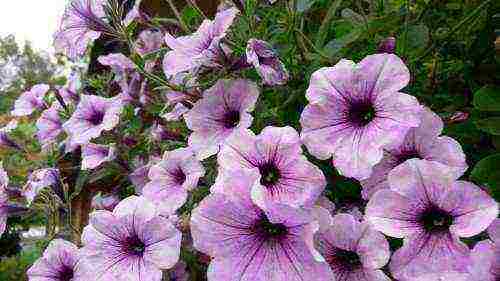 Appearance
Appearance
After flowering, a seed box is formed on the bush, resembling an onion. Seeds are brown, small, viable for several years.
Important! Not all modern petunia hybrids (especially those with variegated petals) retain their characteristics during seed reproduction. Such plants propagate vegetatively, keeping the mother bush in a cool and bright room in winter. In the spring, cuttings are cut to obtain new plants.
Types and varieties
All varieties of petunias are shared:
- bush forms, which, in turn, are divided into large-flowered and small-flowered plants;
- ampelous;
- cascading.
Petunia hybrid
Obtained from crossing different natural forms of the plant. It is a perennial, but usually grown as an annual crop.
The plant is bushy, branched, up to 60 - 70 cm high; additional splendor is achieved by keeping the stepsons on the bush. Flowers are single, can be: simple, double, with a corrugated edge, up to 12-15 cm in diameter. Blooming petunia spreads a pleasant unobtrusive aroma. Abundant flowering, lasts from late May until frost.
There are several forms of hybrid petunia.
- Multi-flowered form... The most unpretentious group of plants, forming a lush bush, abundantly covered with medium-sized (3 - 5 cm in diameter) simple flowers. The color of the petals: white, pink, red, lilac, purple, there are two-color varieties. Varieties:
Snow globe (bush, 40 cm high, abundantly covered with snow-white simple flowers);
Alderman (bush reaches a height of 30 cm, flowers are deep blue, up to 5 cm). - Large-flowered form... The group is represented by rather capricious plant varieties, but it is considered the most beautiful. The diameter of flowers of various forms of the structure of the corolla reaches 13 - 15 cm. Only a few buds bloom on the bush at the same time, but their size and shades are striking. Varieties:
Triumph (diameter of double flowers of various shades, reaches 15 cm);
Pikoti (plant height 30 cm, colors - crimson and red, blue with white edging, corolla size 6 - 8 cm);
Pink sky (bush height up to 30 cm, flowers are large, bright pink). - Floribunda... A successful hybrid that combines an abundance of flowers and unpretentiousness of a multi-flowered petunia and the beauty of a large-flowered one.
 Hybrid
Hybrid
Ampel petunia
The flower is characterized by the formation of long shoots covered with flowers that hang down. A plant that is quite demanding on heat, nutrition and moisture. Used to decorate balconies, walls. Ampelous forms of petunias are planted in hanging pots, flowerpots. Varieties:
- Ramblin is a group of multi-colored varieties of ampelous petunias, with large flowers and a shoot length of 80 - 90 cm;
- Wave - the length of the shoots of these varieties reaches 120 cm, the flower size is up to 7 cm, the color is purple, purple, blue, pink;
- Avalanche - large-flowered (up to 9 cm) ampelous petunia with shoots, 70 cm long;
- Opera Supreme is an unpretentious ampelous form, forming a lush bush, with small (up to 5 cm) blue, crimson, white or pink flowers.
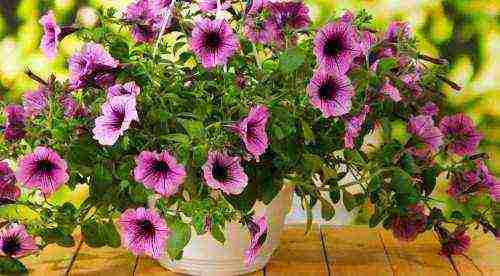 Ampelnaya
Ampelnaya
Cascading petunia
Often the plant is confused with the ampelous form. The difference is in the shape of the bush. In a cascading petunia, shoots grow first up, then, under their own weight, fall down. The shoots of the plant are shorter and thicker than those of the ampelous petunia. Varieties:
- Orchid myst - large-flowered cascading petunia of white-pink color of double flowers;
- Pirouette - double flowers of various colors, varieties are unpretentious;
- Gioconda - the diameter of numerous flowers does not exceed 6 cm, their color: white, pink, purple, orange, scarlet;
- Tornado is an unpretentious group of varieties with large (up to 7 cm) flowers and shoots, more than 100 cm long;
- Burgundy is a profusely flowering variety with large double flowers of purple or deep blue color.
- Surfinia is a petunia that does not belong to ampelous or cascade forms. The length of its shoots reaches 200 cm, they are covered with large flowers of different colors.
Having considered the presented photos of flowers, you can truly appreciate the beauty of petunias.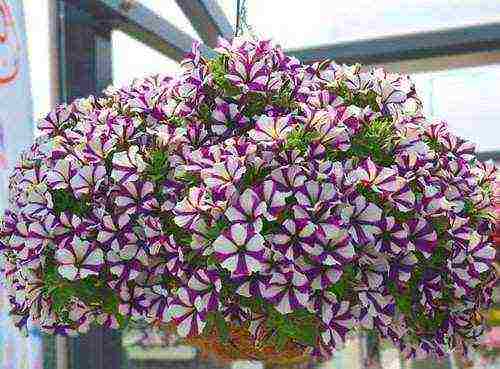 Cascade
Cascade
Choosing a place for a plant
For petunias, it is necessary to select well-lit areas, protected from the wind. The delicate petals of the plant do not withstand gusts of wind, they quickly wither. The flower will be comfortable in a flower bed located near the wall of the building. Often, petunias are planted at the foot of large perennials, the plants do not interfere with each other, and for petunias, wind protection will not hurt.
The flower was widely spread as a pot culture.The plant feels comfortable in the limited space of the pot. Vases or pots with petunias are displayed on balconies, terraces, they decorate the walls of buildings, window sills.
 Petunia in a flowerpot
Petunia in a flowerpot
Soil preparation
The plant makes high demands on the structure and fertility of the soil. Petunia soil is suitable with a neutral or slightly acidic reaction, moisture-absorbing and loose, with a high humus content. Light fertile loams meet these requirements.
Heavy soils are corrected by introducing significant doses of sand (up to 10 kg per square meter) and humus (6 - 8 kg). Sandy soils are ennobled by adding rotted manure and sod land.
For planting plants in pots and flowerpots, the following composition of the soil mixture is used: peat, humus, sand and sod land in equal proportions. For better moisture retention in an earthen coma, experienced flower growers advise adding a hydrogel to the soil. Additionally, a mineral fertilizer complex for petunias is applied, normally according to the instructions.
Care
Petunia needs careful care, only then will she show herself in all her glory. The soil in the flower garden is kept in a weed-free state, it is regularly loosened shallowly.
Water the petunia only with water heated in the sun, strictly at the root, twice a week. In hot weather, flowering plants require daily evening watering.
Flower dressing is applied twice a month, in the form of liquid solutions. Immediately after planting the seedlings, the main element in the fertilizer composition is nitrogen. He is responsible for the active growth of green mass.
During budding and flowering, petunias are fed with a predominance of phosphorus and potassium. It is convenient to use ready-made complexes for petunias or universal flower fertilizers (Pokon, Kemira Lux, Rainbow, Fertika).
To preserve the decorative effect of petunia bushes, the faded buds are removed from the plant. Ampel and cascade forms of plants can be formed by cutting, giving them the desired shape.
Pests, diseases
Petunia is a delicate plant that is affected by a number of ailments.
- Powdery mildew spreads during damp and cold summers. At risk are densely planted plants that receive watering not at the root, but in the foliage. Fungal disease is manifested by the appearance of a whitish coating on the leaves and stems of the plant.
The affected parts of the plant are removed, densely planted bushes are planted. Petunia is treated with Topaz solution or other similar fungicide, sprinkling the plant abundantly. - Blackleg. A common fungal disease on flower seedlings. On the stems of young plants, at the soil level, constrictions of brown or black color are formed. The bush falls and dries up.
The fight against black leg consists in prevention: watering the seedlings only with warm water, with the addition of potassium permanganate crystals. After watering, the soil is loosened, sprinkled with dry calcined sand or sifted wood ash. - Late blight. The disease occurs on weakened plants, during cold nights and growing. At the first signs of the disease, petunia is sprayed with Profit, Ridomil. Preventive treatments with garlic infusion or milk whey solution will help.
A strong and sturdy plant has good immunity and is able to resist pathogens. Providing petunias with enough light, nutrition and moisture, the grower does not have to treat the plants.
A number of pests are not averse to feasting on a flower.
- Whitefly. Microscopic white moths can cause significant damage to flowers. The main sign of the presence of a pest will be yellowing of the foliage and the general depression of the plant. With a large number of whiteflies, the petunia is sprayed with Aktara.
- The spider mite feeds on the sap of the plant, entangling the flower with cobwebs. The drugs Neoron, Apollo help from the pest.
- Aphids not only mechanically harm petunias by sucking juices from the plant, but also contribute to the spread of fungal diseases.Flowers are sprayed with Aktara or Fufanon.
- Slugs love moist soil, and parasitize in areas where there is excess moisture. The fight against slugs consists in sprinkling the earth around the petunia with superphosphate, mustard, and StopSlug.
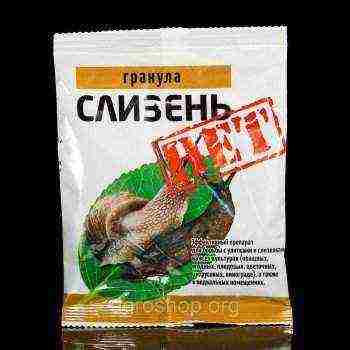 Remedy for slugs
Remedy for slugs
Reproduction
Petunia is most often propagated by seed. They can be collected from their flowers on their own (they have time to ripen in the middle lane) or bought in a store.
Petunia seeds are very small, sometimes seed producers process them. Dragee seeds are easier to sow, their fertilizer shell allows the plant to receive nutrition as soon as a sprout appears.
Petunia, in order to enjoy flowering longer, is sown on seedlings early - at the end of January or February. The soil is prepared from a mixture of peat, sand, turf humus. Petunia can be sown in boxes or immediately in separate pots, peat tablets.
Important! Seeds are laid out on the soil surface, without sprinkling with earth!
Some gardeners practice sowing petunias on the snow, sowing seeds on a layer of snow laid on seedling soil. This method helps to distribute the seeds evenly (dark seeds are clearly visible on the white snow). The snow, gradually melting, feeds the seeds with useful melt water.
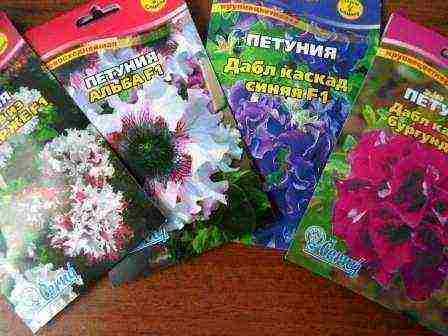 Seeds
Seeds
Crops are kept covered with foil or glass in a warm place until germination. After the emergence of seedlings, the shelter is removed gradually, accustoming the seedlings to fresh air.
Seedling care consists in watering, loosening and picking in the phase of 4 - 5 true leaves. Until the beginning of April, planting petunias must be supplemented, extending daylight hours to 11 hours. During the cultivation of seedlings, it is fed twice:
- a week after germination with nitrogen fertilizer;
- after a pick - potash.
Petunia is planted in the ground only when warm weather is established. Lowering the temperature to 0 degrees can destroy a delicate plant.
The distance between petunia bushes is maintained at least 30 cm for compact forms, and at least 60 cm for large ones. There is a vegetative way of reproduction of petunias - cuttings. It is used for varieties that do not retain their qualities during seed reproduction.
 Seedling
Seedling
In the fall, the mother plant is placed in a spacious pot and stored in a bright and cool (temperature +14 +18 degrees) room. Petunia is not fed, not watered often.
By March, the bush is brought into the heat, watering is increased, nitrogen fertilization is applied. When stepchildren actively grow on the plant, they are cut off and rooted. The cut of the cuttings is dusted with Kornevin or Heteroauxin, the branches are placed in wet sand or vermiculite. From above, the container with cuttings is covered with a greenhouse.
The cuttings are regularly aired or watered moderately. After 2 - 3 weeks, a good root beard is formed on the seedlings. Seedlings from cuttings are planted in a flower bed in the same way as plants obtained from seeds.
Partners
The flower has a bright and attractive appearance, it is self-sufficient. Petunia is beautiful in single plantings, only varieties with different flower colors are selected.
On the flowerbed, petunia looks harmoniously with viola, cirrhea, dicentra, geraniums, marigolds, and Turkish cloves.
Petunia is often used as a "lower floor", planting it to large perennial plants.
Watch also a video on the topic:
Similar articles
